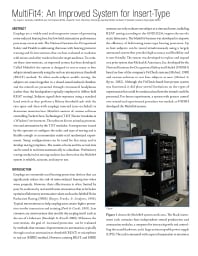Mining Publication: MultiFit4: An Improved System for Insert-Type
Original creation date: September 2010
Authors: AJ Kwitowski, AM Carilli, RF Randolph
Earplugs are a widely-used and inexpensive means of preventing noise-induced hearing loss, but low field attenuation performance puts many users at risk. The National Institute for Occupational Safety and Health is addressing this issue with hearing protector training and fit interventions that are best evaluated at worksites with miners and other workers from the target audience. To evaluate these interventions, an improved system has been developed. Called Multifit4, the system is designed to test as many as four subjects simultaneously using the real-ear attenuation at threshold (REAT) method. To allow multi-subject mobile testing, the subjects are seated together in a closed sound-isolated chamber, and the stimuli are presented through circumaural headphones (rather than the loudspeakers typically employed in diffuse-field REAT testing). Subjects signal their responses using a standard hand switch as they perform a Bekesy threshold task with the ears open and then with earplugs inserted (ears occluded) to determine insertion loss. Mutifit4 consists of custom software controlling Tucker Davis Technologies (TDT) Series 3 modules in a Windows® environment. The software directs stimulus presentation and attenuation by the TDT modules. A setup screen is used by the operator to configure the order and type of testing and is flexible enough to accommodate multi-trial randomized experiments. Setup configurations can be saved for fast setup and to develop testing templates. The results of tests and the actual data can be saved in real time automatically to a database. Preliminary testing conducted on mining students has shown that the Multifit4 system is reliable, accurate, and easy to use.

- Best Practices for Annual Hearing Tests
- Evaluation and Development of Hearing Loss Interventions
- Increasing the Effectiveness of Targeted Mining Hearing Conservation Program Elements
- Inquiring Ears Want to Know: A Fact Sheet about Your Hearing Test
- NIOSH Hearing Loss Prevention Unit is at CONEXPO-CON/AGG
- NIOSH Hearing Loss Simulator Instruction and Training Guide
- NIOSH Tools For Hearing Loss Prevention Programs
- Noise and Hearing Protection: Development of Two Training Exercises for Drillers
- What Does a Hearing Loss Sound Like?
- Working in Noise with a Hearing Loss: Perceptions from Workers, Supervisors, and Hearing Conservation Program Managers